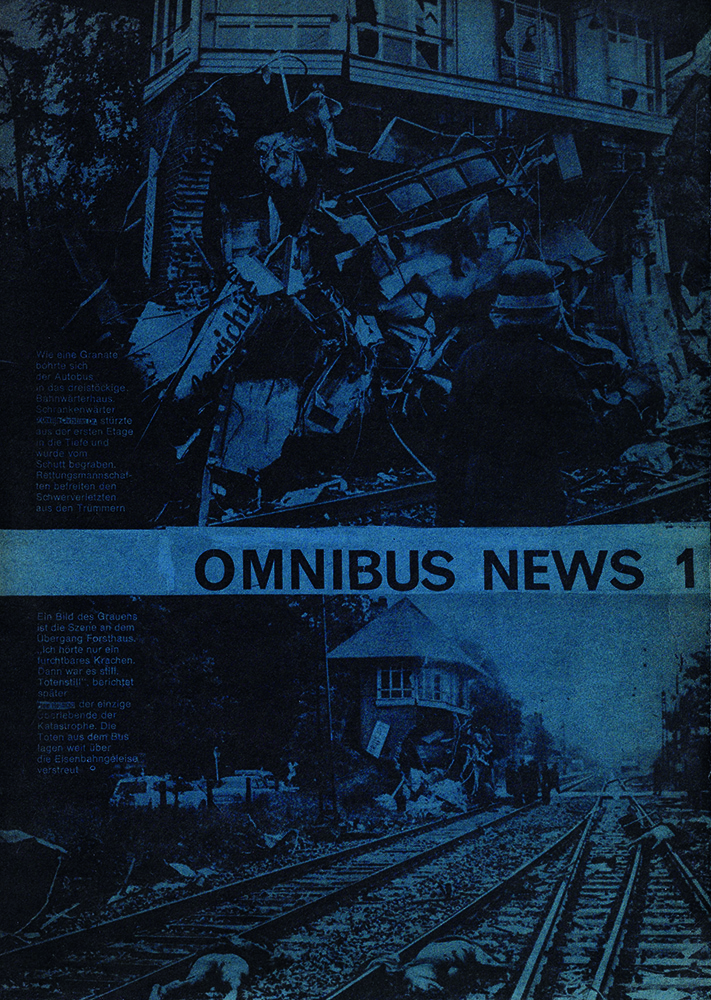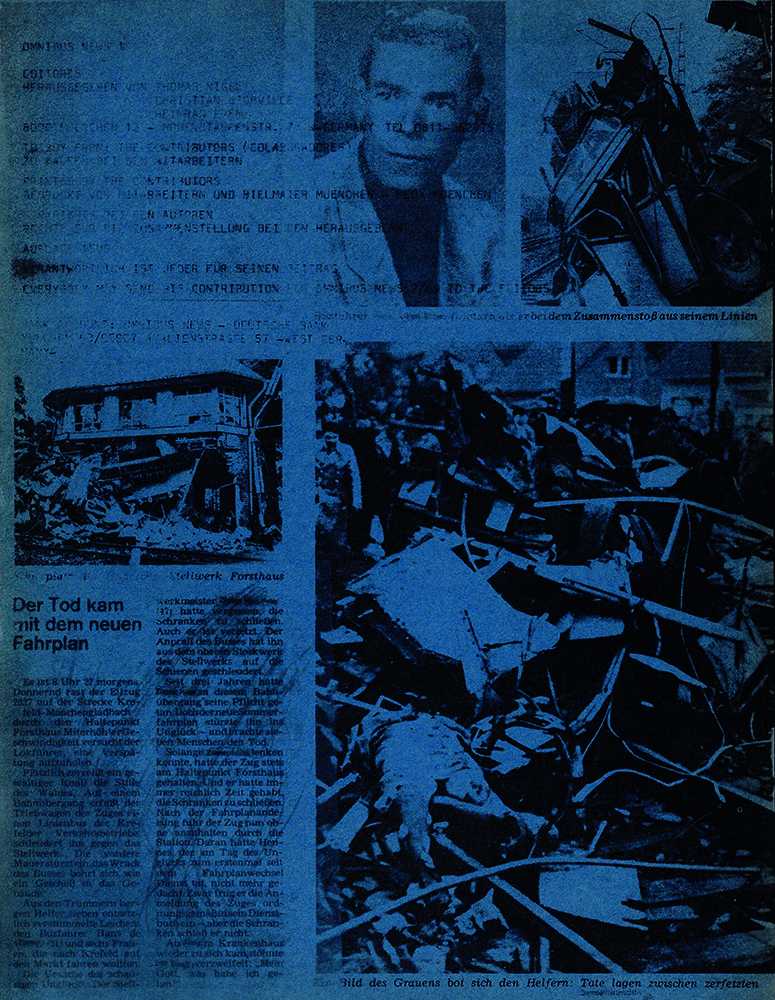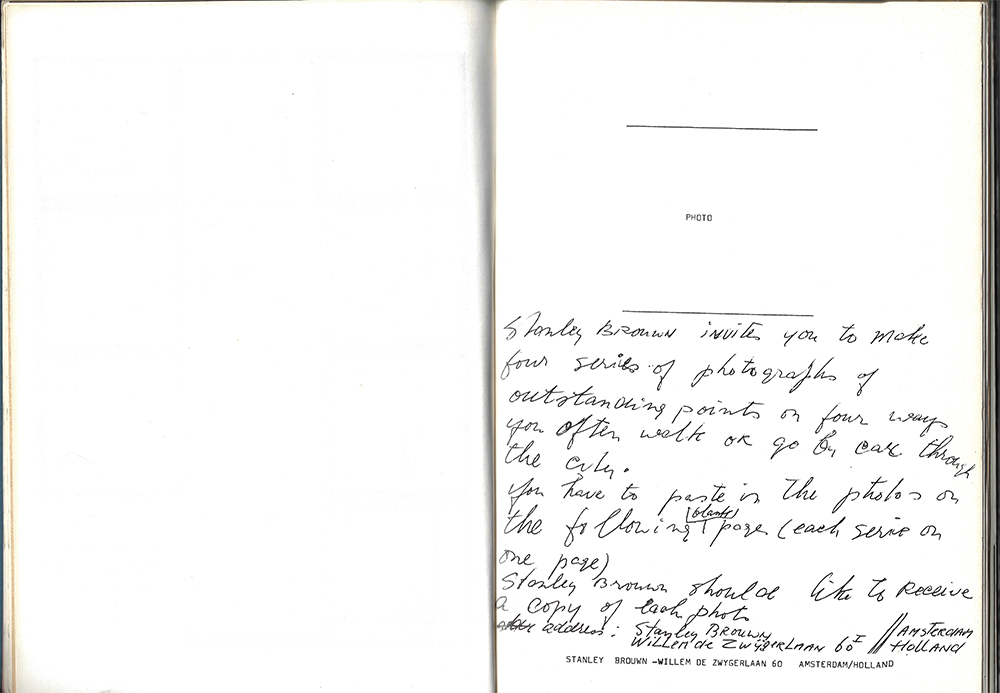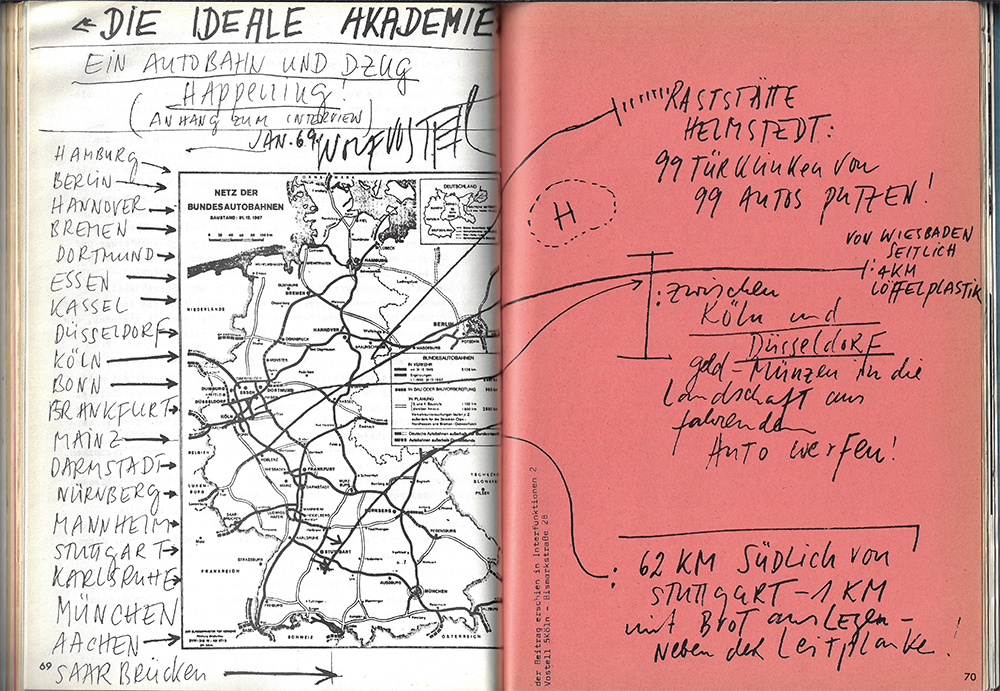OMNIBUS NEWS
Omnibus News - n. 1 [unico pubblicato]
Luogo: München
Editore: edizione autoprodotta
Stampatore: senza indicazione dello stampatore
Anno: 1969 [settembre/ottobre]
Legatura: brossura
Dimensioni: 29,7x21 cm.
Pagine: pp. [384]
Descrizione: prima e quarta di copertina illustrate in bianco e nero virate in bleu, con le immagini di un incidente mortale, la collisione di un treno e di un autobus. Volume interamente illustrato con testi, disegni e immagini fotografiche in bianco e nero per la gran parte, alcune a uno o due colori, impressi su carte di diversa qualità e colore. Raccolta dichiaratamente eterogenea e senza censure di progetti, documenti e riproduzioni di opere, tutti inediti di 114 artisti rigorosamente in ordine alfabetico. Tiratura di 1500 esemplari. Esemplare completo delle due pagine con la lista dei collaboratori, copertina virata in bleu. Unico volume pubblicato, edizione originale.
Bibliografia: N. D.
Prezzo: € 350ORDINA / ORDER
Redattori: Thomas Niggl, Christian D'Orville e Heimrad Prem. Fra gli artisti presenti: Dietrich Albrecht, Eric Andersen, Stanley Brouwn (contributo di 8 pagine), gruppo COMFAC, Wolfgand Feelish, Jochen Gerz, Dick Higgins, Milan Knizak, Thomas Niggl, Hermann Nitsch («Text zum O.M. Theater»), Christian d'Orville, Heimrad Prem, Arnulf Rainer, Hermann Richter, Klaus Staek, Timm Ulrichs («totale sonnenfinsternis», 1968; «totales musik-theater», 1964; «mauerwerk 4», 1963/1968), Ben Vautier, Wolf Vostell («Zur idealen Akademie»).
“Il mio interesse per OMNIBUS NEWS si manifesta prima di tutto nella mia curiosità di scoprire cosa potrebbe nascere da questo assemblaggio di fogli. L’eterogeneo e l’accidentale, l’importante e il non importante. Inoltre sono interessato a sapere se esiste un tono comune, la possibilità di convergenze e connessioni, o se è sciocco anche solo chiedere questo. Una cosa è certa: l’aspetto sperimentale di OMNIBUS NEWS, attraverso la consapevole eliminazione dei valori convenzionali e direzioni tematiche, dovrebbe trovare posto all’interno dell’opposizione al mondo ufficiale dell’arte” (traduzione italiana dal testo introduttivo in tedesco di Christian D’Orville).
"Omnibus News contains a wide assortment of visual works, literary & theoretical texts, proposals & documentation, and reproductions of extant works created in a variety of media. At the end of the periodical is a three page listing of the contributor’s names and addresses.A survey of the contributor’s list reveals submissions from eight countries, with an 82% majority from Germany. For reasons that remain obscure the editor’s would not repeat this publishing experiment and periodicity itself would be another convention that they discarded. However, Omnibus News remains a landmark publication in establishing a new genre of periodical publishing that would come to be known as «assembling» periodicals. Assemblings embrace a radical new editorial model in which the traditional authority of the editor is overthrown, and s/he now becomes an ‘assembler/compiler’ in an open and uncensored publication process. Although this type of editorial model had been used before, it was always within the context of smaller and intimate friendship networks. Omnibus News was a significant break in this tradition as it opened itself up to a much larger international network of potential contributors. The year 1969 also represents a watershed moment in which assembling periodicals would appear in other countries, in particular Canada and the United States. Indeed, the name «assembling» comes from a well-known American example appropriately titled Assembling that published 12 issues between 1970-1986. Omnibus News remains an historical pioneer in establishing this democratized model as an alternative to traditional periodical formats and assemblings continue to be published up to the present day" (Stephen Perkins, 2008).
Esistono esemplari con la copertina virata in rosso e altri in giallo.
“Il mio interesse per OMNIBUS NEWS si manifesta prima di tutto nella mia curiosità di scoprire cosa potrebbe nascere da questo assemblaggio di fogli. L’eterogeneo e l’accidentale, l’importante e il non importante. Inoltre sono interessato a sapere se esiste un tono comune, la possibilità di convergenze e connessioni, o se è sciocco anche solo chiedere questo. Una cosa è certa: l’aspetto sperimentale di OMNIBUS NEWS, attraverso la consapevole eliminazione dei valori convenzionali e direzioni tematiche, dovrebbe trovare posto all’interno dell’opposizione al mondo ufficiale dell’arte” (traduzione italiana dal testo introduttivo in tedesco di Christian D’Orville).
"Omnibus News contains a wide assortment of visual works, literary & theoretical texts, proposals & documentation, and reproductions of extant works created in a variety of media. At the end of the periodical is a three page listing of the contributor’s names and addresses.A survey of the contributor’s list reveals submissions from eight countries, with an 82% majority from Germany. For reasons that remain obscure the editor’s would not repeat this publishing experiment and periodicity itself would be another convention that they discarded. However, Omnibus News remains a landmark publication in establishing a new genre of periodical publishing that would come to be known as «assembling» periodicals. Assemblings embrace a radical new editorial model in which the traditional authority of the editor is overthrown, and s/he now becomes an ‘assembler/compiler’ in an open and uncensored publication process. Although this type of editorial model had been used before, it was always within the context of smaller and intimate friendship networks. Omnibus News was a significant break in this tradition as it opened itself up to a much larger international network of potential contributors. The year 1969 also represents a watershed moment in which assembling periodicals would appear in other countries, in particular Canada and the United States. Indeed, the name «assembling» comes from a well-known American example appropriately titled Assembling that published 12 issues between 1970-1986. Omnibus News remains an historical pioneer in establishing this democratized model as an alternative to traditional periodical formats and assemblings continue to be published up to the present day" (Stephen Perkins, 2008).
Esistono esemplari con la copertina virata in rosso e altri in giallo.




